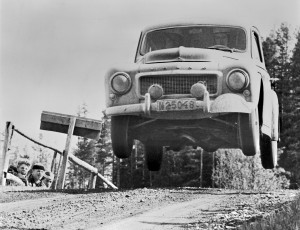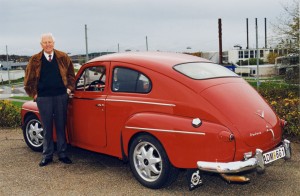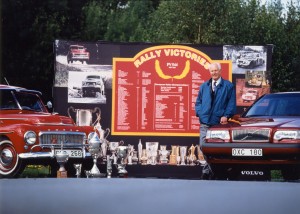
An airborne Gunnar Andersson in his PV during the 1958 Midnight Sun Rally, which he won. For marketing reasons Volvo retouched this photo, making a PV544 out of the 444 that he actually drove.
Gunnar Andersson was born in the Swedish province of Dalsland, on 17 April 1927, three days after the first Volvo car left the factory in Gothenburg. When Andersson was 10, his family moved to Gothenburg and after school, he joined the Air Force, training to be an aircraft technician. He also began to repair and sell cars in a nearby rented garage.
Andersson passed away earlier this month.
In 2001, Gunnar Andersson gave an interview on the eve of Volvo’s, and Gunnar’s, 75th anniversary. Our thanks to Volvo for supplying it to us.
“In 1953, I came by a Jaguar XK120,” Andersson said, “and decided to enter an open driving skills competition in central Gothenburg. There were over a thousand entries, who had to complete ten different tests in a given time. Of those who passed the first nine, the winner was the driver who was fastest in the tenth. “The tenth test was to reverse through an obstacle course. Since the Jaguar was fast also in reverse and since I had a clear view with the top down, I was the overall winner.”
This gave him a taste for more racing and he entered a famous hill-climbing race where he was clocked driving so fast that the organizers queried their own timing. Seizing the chance, the rest of the field entered a protest and the run was abandoned. Then, Gunnar finished only 3rd overall. Gunnar Andersson, age 26, knew that he was a top-rank driver and his rally career was launched. Gunnar had joined the Volvo Service School to support his growing racing habit.
In 1957, he was sold a Volvo PV 444 on the grounds that “they never break down.” Although slightly dubious about the claim, Gunnar made he deal and bought a PV from a Gothenburg Volvo dealer. Volvo fitted an “American spec” 85 horsepower engine in the car, and Gunnar started to use it in rallies and ice races.
 He entered the European Rally Championship in 1958. The first rally was held in Greece, and he led the overall championship after only a few events. In Sweden, he won the Midnight Sun Rally with co-driver Ellemann-Jakobsen and was rapidly becoming famous. Volvo boss Gunnar Engellau was quick to realize the marketing value of these triumphs and Gunnar started to appear in Volvo marketing materials.
He entered the European Rally Championship in 1958. The first rally was held in Greece, and he led the overall championship after only a few events. In Sweden, he won the Midnight Sun Rally with co-driver Ellemann-Jakobsen and was rapidly becoming famous. Volvo boss Gunnar Engellau was quick to realize the marketing value of these triumphs and Gunnar started to appear in Volvo marketing materials.
“I was supposed to work as an instructor at the school,” Andersson said,” but I could not combine it with my rally career,” he explained. “So I transferred to a combination of marketing and driving.
“1958 was my best year, although I decided not to compete in the RAC rally in Britain since I had already won the overall European Championship. This is something I have regretted ever since – I would have been unbeatable and an RAC win is something special.”
Gunnar Andersson was not exclusively a Volvo works driver. In 1959, he won the Swedish Track Racing Championship as a private entrant, ahead of Tom Trana who was also to achieve a successful Volvo works driver.
“I liked being a part of Volvo”, Gunnar said. “It was fun to drive a Swedish car, especially far from home like in Argentina. And the Volvo crew had a fantastic team spirit.”
It was in Argentina that Gunnar achieved one of his greatest victories in his PV, winning the Gran Premio in 1960. Two years later, Volvo swept the board in the same event, taking six of the top eight places.
In 1961, Gunnar entered the classic Italian cross-country race, the Mille Miglia, in a Ferrari 250GT Berlinetta – and was the overall winner. To commemorate this victory, he was invited to take part in an exhibition version of the Mille Miglia in 1984. Although driving a white Volvo PV544 on this occasion, he was universally recognized and hailed by the Italian fans.
In 1962, Gunnar Andersson was summoned by Gunnar Engellau and asked to scale down his rally involvement and take the job of competition department manager. Although the prospect did not appeal to him, Gunnar, reluctantly, accepted and promoted the careers of a number of promising young drivers, including Tom Trana, Carl-Magnus Skogh, Bengt Söderström and Sylvia Österberg.
He still competed in rallies and crowned his career by winning the European Championship in 1963. While Tom Trana won the RAC two years in a row, and became the Champion in 1964.
Under the direction of Gunnar Andersson, Volvo continued to produce rally accessories for dedicated enthusiasts while Volvo management decided to terminate all competition activities after some severe accidents.
In 1972, Gunnar established the Volvo Track Racing Trophy, in which 80 competed in their Volvo 140s. Five years later this event was superseded by an equally attractive trophy for Volvo-badged rally cross cars and a Volvo 343 was also built in 1977 especially for the Swedish Rally cross Championship which also became champion in the hands of Per-Inge Walfridson.
The management’s enthusiasm for competition was rekindled and Volvo established a works stable once again –The Volvo R-Team — to support the Volvo 343 in rally cross events with the European Championship as the ultimate of many prizes during some five years.
“Once the 343 rally cross venture was over, it was time for me to quit the competition scene”, Gunnar Andersson said. “For a number of years, I was something of an ambassador for Volvo. I travelled the world for various product launches and, among other things, I was involved in crash testing. And, of course, I did odd spectacular test drives.
“I enjoyed a number of incredibly enjoyable years before I officially retired at the age of 65 in 1992, but I continued to travel as a Volvo ambassador for several years. Nevertheless, I still regard 1958 as the most enjoyable year of my life. This was when I won my first European Rally Championship and I will never forget the feeling.”
The rest, as they say, is now history.
|
Titles won by Volvo during Gunnar Andersson’s time as works driver and competition director |
| 2 World Championships for constructors |
| 5 European Rally Championships |
| 1 European Rally Cross Championship |
| 1 Nordic Rally Cross Championship |
| 17 Swedish championships in Rally and Rally Cross |


